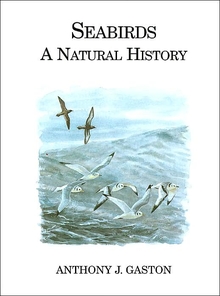Reviewed by Grant McCreary on November 25th, 2008.
There’s just something about seabirds. They aren’t especially visually striking; most are somberly dressed in a mixture of white, gray, black, or brown. They don’t have musical, or even pleasant sounding, voices. But there is still a feeling of something…”other” about them. Their otherness is the focus of this natural history, as it seeks to reveal how they are unique among the birds.
The collective term “seabird” does not refer to any taxonomic classification or grouping. Instead, quite simply, it is applied to any species that leads an essentially marine, or oceanic, existence. This would include all of the penguins, tubenoses (albatrosses, petrels, shearwaters, and the like), and auks, as well as some of the gulls and terns, just to name a few. Basically, any bird that one normally has to see from a boat.
The author has coined the term “seabird syndrome” to encompass the collection of attributes that mark them as different from landbirds, including low reproductive rates, long lives, deferred breeding, coloniality, and sexes that behave and look alike. Other groups of birds may have some of these traits, but seabirds alone possess all of them. (Interesting tidbit: among landbirds, vultures are the closest to seabirds in terms of these characteristics.) It is no accident that these birds, from across many different families, share these traits. They are all adaptations to a marine lifestyle, made necessary because of their feeding ecology.
Gaston focuses his book on the patterns of behavior and ecology that make up the seabird syndrome. He covers population dynamics, feeding, migration, breeding, distribution, plumage, and other special adaptations. There is a ton of information here, but perhaps the most interesting thing is how the author attempts to tie it all together. It is quite amazing to consider that almost every portion of these creatures’ lives, even seemingly unrelated traits such as lifespan, can be traced back to their choice in feeding grounds.
However, this is not a comprehensive study. Focusing on what makes marine birds different results in what the author admits is a “somewhat uneven treatment of seabird biology”. For instance, one subject barely mentioned is courtship displays, even though some of these birds (especially frigatebirds) are well known for their elaborate or bizarre rituals. Additionally, conservation status and threats is obvious in its absence. Some of these birds, especially the long-lived albatrosses, are imminently jeopardized directly and indirectly by people.
A more complete coverage would obviously be preferable, but these omissions are understandable given the author’s purpose for this book. Prospective readers just need to be aware of what they will find here.
Seabirds is definitely more technical than your average general market bird book. It can read like a scientific paper at times, especially when dealing with tables and graphs. However, it seems that the author has attempted to strike a balance between the needs of professional and amateur audiences, and for the most part has succeeded. For the former, he has synthesized the results of many scientific studies and has presented a hypothesis in the form of his seabird syndrome. But he has still managed to keep it readable for the rest of us. It is not a light read, but it presents a great deal of information in an understandable and digestible format, while keeping it more interesting than it otherwise could have been.
Unsurprisingly, given its more technical approach, this book is not lavishly illustrated. However, some color photographs, grouped together on 16 pages in the middle of the book, are a welcome inclusion. Most of the various seabird groups are represented, giving any unfamiliar reader a general idea of what these birds look like. There are also scattered black-and-white photographs and drawings throughout the book.
Recommendation
This natural history is essential to anyone studying seabirds, and highly recommended to anyone strongly interested in them. For everyone else, I would recommend first reading Eye of the Albatross, by Carl Safina (wonderful, wonderful book!). Afterward, if you find that you would like to learn more about these intriguing birds, especially how and why they are so different, you will know where to turn.
Disclosure: I get a small commission for purchases made through links in this post.





Comment